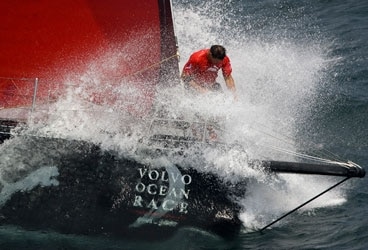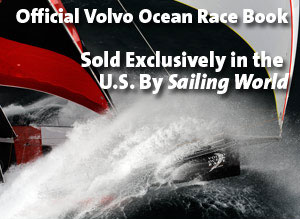
368 kirby
Now that the Volvo Ocean Race is over, I sat down with Puma Racing Team crewmember Jerry Kirby to discuss what lessons cruising sailors could take away from the extreme environment of that race. At 53, Kirby is a Volvo Ocean Race and America’s Cup veteran who’s usually on the leading edge of the next new thing at the very pinnacle of competitive sailboat racing.
Jobson: What things really worked well on il mostro, the Puma team boat, that you’d recommend for a cruising boat?
Kirby: Every boat that I’ve ever been on offshore seems to have the generator running constantly. We always seem to be forever losing power and caught in a constant cycle of trying to keep the batteries up. While I can’t go into specifics for competitive reasons, I can say that the battery-charging system that electrical and electronics experts Evan Evans and Sean Healy put together for us worked really well. We had these special batteries that essentially recharge very quickly. They were light and compact, and we charged them with two big alternators. The system was very efficient and allowed us to charge our batteries in 20 minutes and only required us to run the engine a couple of times a day. This was a unique system for us, but I think offshore cruisers could benefit from this technology once it trickles down.
Jobson: What sail materials proved to be most reliable over the long haul?
Kirby: We didn’t experience as much laminate and glue failure as most of the other boats in the fleet, and that might be because most of our sails were red. Ultraviolet radiation is a big problem with Dacron and laminated sails, and it may be that the red in our sails acted as a UV filter even if our sails may have actually been a bit hotter in the sun. And there might be something to that, since our sails weathered better that any other sails in the fleet.
Jobson: So should cruising sailors ask their sailmaker to put red tint in their sails?
Kirby: I think they should.
Jobson: What techniques did you develop to be able to sail shorthanded most of the time?
Kirby: Most of those techniques were developed before we started the race. We had lots of practice, and we knew what needed to happen in almost every scenario. Sail changes were always the biggest challenge, but a Volvo boat is almost like a cruising boat in that we do have some roller-furling headsails to make things a little easier. All the big race headsails are set on beefy furling systems, so when it gets really ugly, we did exactly what a cruiser would do-we rolled up the headsail. That said, we’d be working hard to get the next biggest sail up, and we’d never, never sail with a partially furled headsail, the way a cruiser might. When it came down to dealing with the spinnakers, we wouldn’t wake guys up to set one, but we would when it came time to take one down because you always need a couple of extra hands on deck in those situations.
Jobson: What tools proved to be most valuable? If you had to prepare a small tool kit, what would you bring out there?
Kirby: Cruisers are really like Volvo sailors. When you leave the dock, you’re your own mechanic and your own boatyard. You’ve got to take care of your own food and safety, too, so the more prepared you are, the better. For most mechanical fixes, you should have a small tool bag containing adjustable wrenches, Vise-Grips, assorted screwdrivers, and the like. And you should fit out the tool bag to be specific to your boat. Do your homework and really know what you need and what you might need. Don’t just throw an entire Craftsman tool kit you got from Sears into the boat and say, “OK, some day I’ll need all this.” Figure out specifically what tools you’ll need and choose your spare parts carefully.
Jobson: Are there any epoxies or other kinds of repair materials that you’d recommend?
Kirby: We carried West System epoxy and such boat-repair basics as carbon fiber and fiberglass cloth. We also brought pieces of sheet metal in various sizes so we could through-bolt a repair and just use the glue to hold it until we got to shore, where the professional boatbuilders could do a permanent repair. There was no time to do big layups.
Jobson: The America’s Cup has a long history of technological innovation, and often these new ideas trickle down through the rest of the sailing world. What did you see in this Volvo Race that might be on the way to cruising sailors?
Kirby: Some of the foredeck systems. I think in the next Volvo Race, depending on what happens, you might see a setup more like the singlehanded Vendée Globe boats. The crews will be smaller, and the boats will have a lot more sail area. That will mean more roller-furling sails and sleeve-type spinnakers.
Jobson: What can cruisers learn from what you guys ate?
Kirby: We ate mostly freeze-dried food, and if you’re going to use freeze-dried food on a long cruise, it’s important to do your homework. You might think that an Asian rice dish is going to taste the same way freeze-dried as it does at a nice Chinese restaurant, but more often than not, that’s not the case. When it comes to freeze-dried food, do a taste test first and see what’s best before you load up with stuff you might not like.
Jobson: What were some of your favorite meals?

|
Kirby: I have got to take my hat off to Rick Deppe. He was the media guy on our crew, but he also prepared our meals. He made sure to bring along some plastic bags of tomato paste, and he always had some spices in the rack, which didn’t add any weight. Those spices that we could add to whatever freeze-dried meal we had helped us turn it into something we’d eat and say, “Wow, that’s great!”
Jobson: I know onboard weight is an issue. How much clothing and personal items were you allowed to take with you?
Kirby: That’s always a tough one. I didn’t take much because it all comes down to how well you take care of your personal hygiene. If you’re good at keeping yourself relatively clean, you don’t need as many clothes. My secret is that I bring quite a few spare socks, not because I’m going to need them, but because I know that deep in the Southern Ocean, they’re a great trading item-socks for chocolate.
Jobson: I know you aren’t taking a nice freshwater shower everyday. How do you guys keep clean?
Kirby: Baby wipes. We have to be careful with our hands because germs can easily spread throughout the boat. Baby wipes are the first thing I use before touching any food in the galley, and as long as we used soap and baby wipes, hygiene was no problem.
Jobson: Did you change the clothes and gear you brought in your small seabag depending on the leg, or did you take the same kit?
Kirby: What was interesting about this Volvo is that we crossed the equator more times than in previous races. Take the 42-day leg from Qingdao, for instance. We started out in the cold of winter in China, then crossed the equator, going from extreme cold to extreme heat. We also experienced huge temperature changes when we sailed from New Zealand back into the extreme cold in the Southern Ocean, then up to Rio de Janeiro, which was extremely hot. I had one set of clothes for the heat and one set for the cold, and I tried to mix and match as best I could. Because my bag never got any bigger, I just had to be smarter about what I filled it with.
Jobson: What do you wear on night watch in the higher latitudes?
Kirby: The night watch-and, honestly, some of the day watches, too-can be brutal. I wore a thin silkweight top and bottom as a base layer, an expedition-weight layer in the middle, and a protective shell as an outer layer. My advice to anyone sailing in cold climates? Get some really good five-millimeter neoprene gloves. The flexible kind. We’ve gone through every sort of glove there is, but the five-millimeter neoprene gloves seemed to work. And keep an eye out for a Snow Dome hat. It’s made of fleece with earflaps and a nylon outer shell. Since Patagonia stopped selling them, it can be hard to find one. Sometimes one comes up on eBay. You can get it soaking wet, shake it out, put it back on, and it’ll continue to keep you warm. It’s like a magic hat for cold weather.
Jobson: What safety gear did you wear on deck?
Kirby: I found a really good combination chest harness/inflatable life preserver. You won’t drown, and it gives the guys on the boat a chance to come back to you if you do fall overboard. This was sort of a different philosophy than in past Volvo Races, in which most guys just wore a light harness with no life preserver.
Jobson: What watch system did you like the best?
Kirby: Our watch system is four hours on/four hours off, with two new guys every two hours-new blood every two hours on deck through the entire 24-hour rotation. Four on/four off gets your crew into a comfortable rhythm.
Gary Jobson is well-known for his on-camera analysis of the Volvo Ocean Race and the America’s Cup. He’s currently the president of US Sailing.

|







